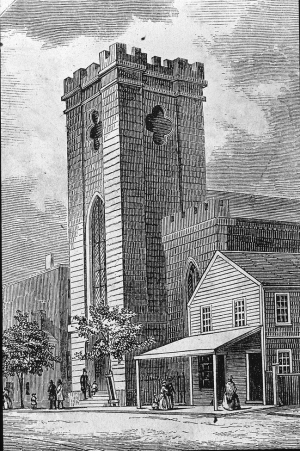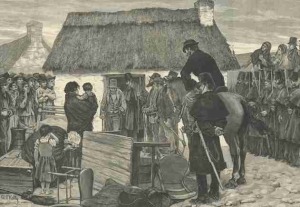The Charlestown Historical Society was founded on January 3, 1967 for the purpose of gathering and recording the history of Charlestown Continue reading
Category: Charlestown History
The Charlestown Historical Society
The Charlestown Historical Society was founded on January 3, 1967 for the purpose of gathering and recording the history of Charlestown, as well as the families and individuals who are associated with the town; to collect and preserve historical artifacts and relics; and to maintain a museum where the collection shall be exhibited.
The organization has had many changes over the years, but has always maintained the mission of telling the history of the town we love so well.
In recent years, the C.H.S. has produced a movie called the Green Square Mile which tells of the history of the Charlestown Irish. We have produced programs that tell the stories of the Charlestown Prison, John Boyle O’Reilly, Lt. P. M. Holmes, and the Charlestown Loopers. We have also hosted historic walking tours led by City of Boston Archeologist, Joseph Bagley.
The C.H.S. continues with the purpose for which it was formed; to foster and promote interest in the historical heritage of Charlestown; to disseminate the information to the public concerning historical site, landmarks, artifacts and events relative to our historical heritage.
You can learn more about The Charlestown Historical Society and their work on their website. Their mailing address is:
Charlestown Historical Society
PO Pox 291776
Charlestown, MA 02129
History of St. John’s
This year, 2015, is the 175th anniversary of the consecration of St. John’s Episcopal Church in Charlestown.
The following account of the origins of St. John’s is reprinted from The Challenge of One Hundred Years, the program book of the parish’s celebration of its hundredth anniversary in May of 1940. Although no author is cited, the account was probably written by the Rev. Wolcott Cutler, sixth rector of the parish, who served from 1924–1959.
How St. John’s Began
 The beginning of St. John’s Parish in 1840 seems to have been entirely due to the vision and initiative of the Diocesan Board of Missions. At the Convention in June, 1839, the Board of Missions recommended that parishes be started in Charlestown and Worcester, because of the rapid growth and importance of the two cities. In November, with the help of the Episcopal clergyman who was serving as chaplain of the Navy Yard, a preliminary meeting of a few men of some prominence in Charlestown resulted in the calling by public advertisement in the Boston Evening Transcript and two other newspapers of a larger general meeting at which the Board of Missions offered to pay the entire salary of a minister, and a committee of six men was appointed to raise the $345 estimated to be necessary for a parish budget. We possess to this day the original minute book with carefully kept records of these preliminary meetings; but, with the usual reticence of Anglicans, they make no slightest reference to what they expected the new parish to accomplish. We are told by an elderly parishioner whose parents lived next door to the young church that for many years St. John’s was the only non-Roman Church in Charlestown that observed either Christmas or Easter, as well as the only place where one might worship in language refined and sanctified by centuries of devotion.
The beginning of St. John’s Parish in 1840 seems to have been entirely due to the vision and initiative of the Diocesan Board of Missions. At the Convention in June, 1839, the Board of Missions recommended that parishes be started in Charlestown and Worcester, because of the rapid growth and importance of the two cities. In November, with the help of the Episcopal clergyman who was serving as chaplain of the Navy Yard, a preliminary meeting of a few men of some prominence in Charlestown resulted in the calling by public advertisement in the Boston Evening Transcript and two other newspapers of a larger general meeting at which the Board of Missions offered to pay the entire salary of a minister, and a committee of six men was appointed to raise the $345 estimated to be necessary for a parish budget. We possess to this day the original minute book with carefully kept records of these preliminary meetings; but, with the usual reticence of Anglicans, they make no slightest reference to what they expected the new parish to accomplish. We are told by an elderly parishioner whose parents lived next door to the young church that for many years St. John’s was the only non-Roman Church in Charlestown that observed either Christmas or Easter, as well as the only place where one might worship in language refined and sanctified by centuries of devotion.
The first public services were held in Fuller’s Hall on the east of City Square, on Sunday, January 5, 1840. Some 75 persons were present in the morning, and more in the afternoon. Within six weeks the rector was holding also a regular mid-week lecture, for which the parish was allowed the use of the Congregational rooms on Town Hill. A Ladies’ Circle was also formed which later in the year held a bazaar at which $800 was cleared. A Sunday School of twenty scholars was organized on May 10.
Meanwhile, within ten weeks of the first public service, and in spite of the fact that only twenty families were definitely associated with the new parish, a committee was appointed to solicit ten thousand dollars for a suitable House of Worship. In less than a month, six thousand dollars was pledged, and a drive was launched with the help of the Board of Missions to raise the other four thousand dollars amount from the four nearest Episcopal parishes of Boston. When nothing came of this effort, the original committee did some further canvassing in Charlestown, with the result that on June 4, 1840, they felt able to assume the full responsibility for the entire ten thousand dollars, and a building committee was organized. A desirable lot of land was secured that fall; the cornerstone was laid on May 5, 1841; and on November 10 of the same year, Bishop Griswold consecrated the completed building.
It is of interest to note that among the twenty-four men whose names appear on the articles of association, ten are persons of sufficient distinction to be referred to in James F. Hunewell’s or in Timothy Sawyer’s works on the history of Charlestown — one was a schoolmaster who had helped the boy Starr King, one of the treasurers of the newly-opened railroad to White River Junction, one a captain of the Bunker Hill Aurora, one the donor of the bronze statue of John Harvard to the University in Cambridge, one the prime mover in tendering a reception to Governor Louis Kossuth of Hungary, and others were of seemingly substantial middle class standing in the community.
Bishop Griswold, in his prayer for the consecration of the Church building, included the following words not used in our present Book of Common Prayer: “I do hereby enjoin that men enter this House with pious reverence and religious awe… that here devout worshipers… confess their sins before God that they may obtain through faith in Jesus Christ and the merits of His blood, perfect remission and forgiveness,… and that in this, the Lord’s House, all the ordinances of Christ be administered and received according to His own appointment; and that all other things be done decently, in good order, and to edifying, to the glory of God and to the salvation of His people.”
Reverend Cutler’s slides
The Reverend Wolcott Cutler of St. John’s recorded a great deal of Charlestown history in glass “lantern slides.” These are preserved by the Boston Public Library. You can see them on Flickr. Continue reading


